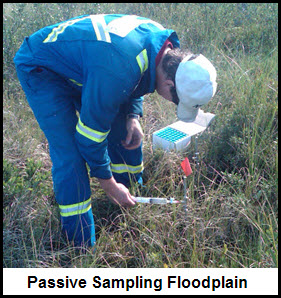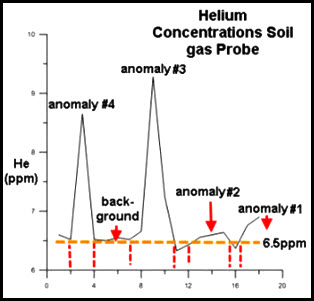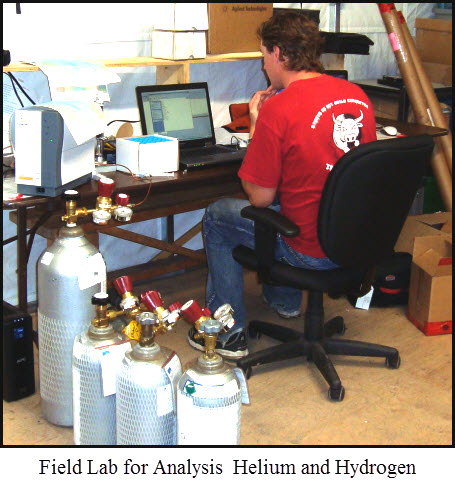

| downloads | revital- ization |
home | contract services |
profile | method | risk assessment |
inter- pretations |
consulting | multi- client |
CO2 | pricing | new concepts |
oilsands | links | benzene | helium |
|---|
Petro-Find Geochem conducts soil gas surveys for uranium exploration using helium and hydrogen as pathfinders. This technology is an adaptation of its proven method for exploration of hydrocarbons using light hydrocarbons as pathfinders. It is well known that all uranium deposits generate helium (i.e. alpha particles) from the decay of uranium. Hydrogen can be produced by radiolysis of water by uranium in a deposit. Helium and hydrogen migrate by diffusion and mass flow (micro-bubbles) vertically to the surface unless short-circuited by fractures/faults. However, the usefulness of hydrogen as a pathfinder is mitigated by the fact it can be generated by other (non uranium related) methods such as redox reactions. Read paper on exploration for uranium.

A new geochemical exploration system for uranium is considered highly desirable by industry because conventional exploration using geophysics (such as EM, magnetics, radiometric and gravity), soil analysis and drilling is costly and time consuming. A technological breakthrough would make structural improvements to ways uranium exploration is conducted worlwide.The higher the grade of the deposit the better the results.
State-of-the-art equipment both for sampling and analysis was developed and proven over a four-year period to measure highly volatile helium and hydrogen in soils. A probe was developed to penetrate all types of soils, especially bouldery tills, without plugging and to prevent mixing with ambient air. The syringe used to transfer the sample from the probe to a vial was experimentally found to be leak-proof for up to 45 minutes, which is considerably in excess of the estimated 10-second transfer time. In laboratory experiments, the sample vials were found to be leak proof for at least 45 days allowing sufficient time for their transport from anywhere in the world to Petro-Find's lab in Saskatoon.

The Petro-Find Geochem soil gas method, using helium and hydrogen as pathfinders, is a proven technology for exploration of uranium in wet sediments (muskeg, flood plains and waterlogged soils)and can be adapted for exploration under deep lakes.
Micro-GC technology to analyze helium and hydrogen was developed to meet Petro-Find's specific needs including: analysis of helium and hydrogen in a single unit; fast turnaround on analysis; high resolution with MDL 5.4 ppm for helium and 0.5 ppm for hydrogen; lightness and portability; and a port/septum for direct sample injection. The ability to conduct helium and hydrogen analysis by a portable Micro-gas chromatograph in a field office close to a project area is considered very important in frontier exploration. Fast and accurate turnaround on analysis can guide day-to-day operations and allow filling in with sample locations to obtain a complete picture before demobilization.

A survey at Nunavut (a northern Canadian Territory) tested the suitability of Petro-Find's soil gas surveys to locate a drill-indicated uranium deposit under thick permafrost and saturated ground to a depth of 3 meters overlying permafrost. It was found that ice (permafrost) is permeable to highly volatile helium and hydrogen. Although surveys for hydrocarbons have been tested in Alaska and Russia, the methods used are dependent on analysis of permafrost cores rather than soil gas. This survey also successfully tested the suitability of conducting soil gas surveys by sampling hummocks, which widely exist in Arctic tundra. The paucity of soil gas in the hummocks required the modification of the probe so that less volume is required to be purged.
A major obstacle in proving up a new geochemical system for exploration of uranium is the availability of drill-indicated deposits for blind testing. This was overcome by partnering with industry who provided access to several drill indicated uranium deposits at various depths up to 600 meters.

PETRO-FIND GEOCHEM LTD
215 Mallin Crescent
Saskatoon, Saskatchewan, Canada S7K 7X3
Contact: Paul Lafleur, President
![]()
Phone: (306)931-3156 Fax: (306)931-9773
E-Mail: plafleur@sasktel.net